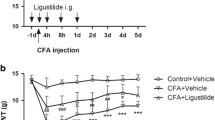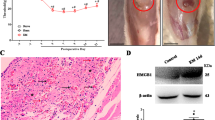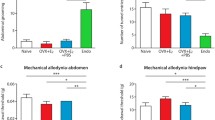Abstract
Estrogen receptor beta (ERβ) has been shown to play a therapeutic role in inflammatory bowel disease (IBD). However, the mechanism underlying how ERβ exerts therapeutic effects and its relationship with P2X3 receptors (P2X3R) in rats with inflammation is not known. In our study, animal behavior tests, visceromotor reflex recording, and Western blotting were used to determine whether the therapeutic effect of ERβ in rats with inflammation was related with P2X3R. In complete Freund adjuvant (CFA)-induced chronic inflammation in rats, paw withdrawal threshold was significantly decreased which were then reversed by systemic injection of ERβ agonists, DPN or ERB-041. In 2,4,6-trinitrobenzene sulfonic acid (TNBS)-induced colitis in rats, weight loss, higher DAI scores, increased visceromotor responses, and inflammatory responses were reversed by application of DPN or ERB-041. The higher expressions of P2X3R in dorsal root ganglia (DRG) of CFA-treated rats and those in rectocolon and DRG of TNBS-treated rats were all decreased by injection of DPN or ERB-041. DPN application also inhibited P2X3R-evoked inward currents in DRG neurons from TNBS rats. Mechanical hyperalgesia and increased P2X3 expression in ovariectomized (OVX) CFA-treated rats were reversed by estrogen replacements. Furthermore, the expressions of extracellular signal-regulated kinase (ERK) in DRG and spinal cord dorsal horn (SCDH) and c-fos in SCDH were significantly decreased after estrogen replacement compared with those of OVX rats. The ERK antagonist U0126 significantly reversed mechanical hyperalgesia in the OVX rats. These results suggest that estrogen may play an important therapeutic role in inflammation through down-regulation of P2X3R in peripheral tissues and the nervous system, probably via ERβ, suggesting a novel therapeutic strategy for clinical treatment of inflammation.








Similar content being viewed by others
References
Berkley KJ (1997) Sex differences in pain. Behav Brain Sci 20(3):371–380
Unruh AM (1996) Gender variations in clinical pain experience. Pain 65:123–167
Chesterton LS, Barlas P, Foster NE, Baxter GD, Wright CC (2003) Gender differences in pressure pain threshold in healthy humans. Pain 101(3):259–266
Craft RM, Ulibarri C, Leitl MD, Sumner JE (2008) Dose- and time-dependent estradiol modulation of morphine antinociception in adult female rats. Eur J Pain 12:472–479
Gintzler AR, Bohan MC, Gintzler AR, Bohan M (1990) Pain thresholds are elevated during pseudopregnancy. Brain Res 507(2):312–316
Dawson-Basoa M, Gintzler AR (1998) Gestational and ovarian sex steroid antinociception: synergy between spinal kappa and delta opioid systems. Brain Res 794(1):61–67
Craft RM (2007) Modulation of pain by estrogens. Pain Suppl 132(1):S3–S12
Sanoja R, Cervero F (2005) Estrogen-dependent abdominal hyperalegsia induced by ovariectimy in adult mice: a model of functional abdominal pain. Pain 118:243–253
Aloisi AM, Ceccarelli I (2000) Role of gonadal hormones in formalin-induced pain responses of male rats: modulation by estradiol and naloxone administration. Neuroscience 95:559–566
Bradshaw H, Miller J, Ling Q, Malsnee K, Ruda MA (2000) Sex differences and phases of the estrous cycle alter the response of spinal cord dynorphin neurons to peripheral inflammation and hyperalgesia. Pain 85:93–99
De Marinis E, Acaz-Fonseca E, Arevalo MA, Ascenzi P, Fiocchetti M, Marino M, Garcia-Segura LM (2013) 17b-Oestradiol anti-inflammatory effects in primary astrocytes require oestrogen receptor β-mediated neuroglobin up-regulation. J Neuroendocrinol 25:260–270
De Marinis E, Acaz-Fonseca E, Arevalo MA, Ascenzi P, Fiocchetti M, Marino M, Garcia-Segura LM (2013) Estradiol receptors agonists induced effects in rat intestinal microcirculation during sepsis. Microvasc Res 85:118–127
Li L, Fan X, Warner M, Xu XJ, Gustafsson JA, Wiesenfeld-Hallin Z (2009) Ablation of estrogen receptor a or b eliminates sex differences in mechanical pain threshold in normal and inflamed mice. Pain 143:37–40
Spooner MF, Robichaud P, Carrier JC, Marchand S (2007) Endogenous pain modulation during the formalin test in estrogen receptor beta knockout mice. Neuroscience 150:675–680
Edvardsson K, Ström A, Jonsson P, Gustafsson JÅ, Williams C (2011) Estrogen receptor induces antiinflammatory and antitumorigenic networks in colon cancer cells. Mol Endocrinol 25:969–979
Cao DY, Ji Y, Tang B, Traub RJ (2012) Estrogen receptor β activation is antinociceptive in a model of visceral pain in the rat. J Pain 13:685–694
Xu S, Cheng Y, Keast JR, Osborne PB (2008) 17β-estradiol activates estrogen receptor βsignalling and inhibits transient receptor potential vanilloid receptor 1 activation by capsaicin in adult rat nociceptor neurons. Endocrinology 149:540–5548
Gardell LR, Hyldtoft L, Del Tredici AL, Andersen CB, Fairbairn LC, Lund BW, Gustafsson M, Brann MR, Olsson R, Piu F (2008) Differential modulation of inflammatory pain by a selective estrogen receptor β agonist. Eur J Pharmacol 592:158–159
Sapsed-Byrnea S, Ma D, Ridoutb D, Holdcrofta A (1996) Estrous cycle phase variations in visceromotor and cardiovascular responses to colonic distension in the anesthetized rat. Brain Res 742(1–2):10–16
Harris HA, Albert LM, Leathurby Y, Malamas MS, Mewshaw RE, Miller CP, Kharode YP, Marzolf J, Komm BS, Winneker RC, Frail DE, Henderson RA, Zhu Y, Keith JC Jr (2003) Evaluation of an estrogen receptor-beta agonist in animal models of human disease. Endocrinology 144(10):4241–4249
Cattaneo M (2015) The platelet P2 receptors in inflammation. Hamostaseologie 35(3):262–266
Burnstock G (2007) Physiology and pathophysiology of purinergic neurotransmission. Physiol Rev 87:659–797
Wynn G, Ma B, Ruan HZ, Burnstock G (2004) Purinergic component of mechanosensory transduction is increased in a rat model of colitis. Am J Physiol Gastrointest Liver Physiol 287:G647–G657
Shinoda M, Feng B, Gebhart GF (2009) Peripheral and central P2X3 receptor contributions to colon mechanosensitivity and hypersensitivity in the mouse. Gastroenterology 137:2096–2104
Xiang Z, Xiong Y, Yan N, Li X, Mao Y, Ni X, He C, LaMotte RH, Burnstock G, Sun J (2008) Functional up-regulation of P2X3 receptors in the chronically compressed dorsal root ganglion. Pain 140:23–34
Oliveira MC, Pelegrini-da-Silva A, Tambeli CH, Parada CA (2009) Peripheral mechanisms underlying the essential role of P2X3, 2/3 receptors in the development of inflammatory hyperalgesia. Pain 141(1–2):127–134
Hsieh YL, Chiang H, Lue JH, Hsieh ST (2012) P2X3-mediated peripheral sensitization of neuropathic pain in resiniferatoxin-induced neuropathy. Exp Neurol 235:316–325
Fan J, Yu LH, Zhang YM, Ni X, Ma B, Burnstock G (2009) Estrogen altered visceromotor reflex and P2X3 mRNA expression in a rat model of colitis. Steroids 74:956–962
Lu Y, Jiang Q, Yu L, Lu ZY, Meng SP, Su D, Burnstock G, Ma B (2013) 17β-estradiol rapidly attenuates P2X3 receptor-mediated peripheral pain signal transduction via ERα and GPR30. Endocrinology 154(7):2421–2433
Ma B, Yu LH, Fan J, Cong BH, He P, Ni X, Burnstock G (2011) Estrogen modulation of peripheral pain signal transduction: involvement of P2X3 receptors. Purinergic Signal 7:73–83
Lu Y, Li Z, Li HJ, Du D, Wang LP, Yu LH, Geoffrey B, Chen AM, Ma B (2012) A comparative study of 17β-estradiol and estriol on peripheral pain behavior in rats. Steroids 77:241–249
Rovenský J, Stančíkova M, Svík K, Bauerová K, Jurčovičová J (2011) The effects of β-glucan isolated from Pleurotusostreatus on methotrexate treatment in rats with adjuvant arthritis. Rheumatol Int 31(4):507–511
Tsubota M, Kawabata A (2014) Role of hydrogen sulfide, a gasotransmitter, in colonic pain and inflammation. Yakugaku Zasshi 134(12):1245–1252
Liu CY, Lu ZY, Li N, Yu LH, Zhao YF, Ma B (2015) The role of large-conductance, calcium-activated potassium channels in a rat model of trigeminal neuropathic pain. Cephalalgia 35(1):16–35
Ji RR, Befort K, Brenner GJ (2002) ERK MAP kinase activation in superficial spinal cord neurons induces prodynorphin and NK-1 upregulation and contributes to persistent inflammatory pain hypersensitivity. J Neurosci 22:478–485
Mannino CA, South SM, Quinones-Jenab V, Inturrisi CE (2007) Estradiol replacement in ovariectomized rats is antihyperalgesic in the formalin test. J Pain 8(4):334–342
Mannino CA, South SM, Inturrisi CE, Quinones-Jenab V (2005) Pharmacokinetics and effects of 17β-estradiol and progesterone implants in ovariectomized rats. J Pain 6:809–816
Taleghany N, Sarajari S, DonCarlos LL, Gollapudi L, Oblinger MM (1999) Differential expression of estrogen receptor α and β in rat dorsal root ganglion neurons. J Neurosci Res 57:603–615
Papka RE, Storey-Workley M, Shughrue PJ, Merchentha-ler I, Collins JJ, Usip S, Saunders PT, Shupnik M (2001) Estrogenreceptor-α and β- immunoreactivity and mRNA in neurons of sensory and autonomic ganglia and spinal cord. Cell Tissue Res 304:193–214
Nilsson S, Gustafsson JÅ (2011) Estrogen receptors: therapies targeted to receptor subtypes. Clin Pharmacol Ther 89:44–55
Harris HA, Bruner-Tran KL, Zhang X, Osteen KG, Lyttle CR (2005) A selective estrogen receptor-βagonist causes lesion regression in an experimentally induced model of endometriosis. Hum Reprod 20:936–941
Chen CC, Akopian AN, Sivilotti L, Colquhoun D, Burnstock G, Wood JN (1995) P2X purinoceptor expressed by a subset of sensory neurons. Nature 377:428–431
Novakovic SD, Kassotakis LC, Oglesby IB, Smith JA, Eglen RM, Ford AP, Hunter JC (1999) Immunocytochemical localization of P2X3 purinoceptors in sensory neurons in naïve rats and following neuropathic injury. Pain 80:273–282
Xu GY, Huang LY (2002) Peripheral inflammation sensitizes P2X receptor-mediated responses in rat dorsal root ganglion neurons. J Neurosci 22(1):93–102
Nakamura T, Katsu Y, Watanabe H, Iguchi T (2008) Estrogen receptor subtypes selectively mediate female mouse reproductive abnormalities induced by neonatal exposure to estrogenic chemicals. Toxicology 253:117–124
Lee ZH, Kim HH (2003) Signal transduction by receptor activator of nuclear factorkappa B in osteoclasts. Biochem Biophys Res Commun 305:211–214
Boyle WJ, Simonet WS, Lacey DL (2003) Osteoclast differentiation and activation. Nature 423:337–342
Khare V, Paul G, Movadat O, Frick A, Jambrich M, Krnjic A, Marian B, Wrba F, Gasche C (2015) IL-10R2 overexpression promotes IL-22/STAT3 signaling in colorectal carcinogenesis. Cancer Immunol Res 3(11):1227–1135
Cui J, Shen Y, Li R (2013) Estrogen synthesis and signaling pathways during ageing: from periphery to brain. Trends Mol Med 19(3):197–209
Adachi T, Kar S, Wang M, Carr BI (2002) Transient and sustained ERK phosphorylation and nuclear translocation in growth control. Cell Physiol 192(2):151–159
Chen XQ, Wang B, Wu C, Pan J, Yuan B, Su YY, Jiang XY, Zhang X, Bao L (2012) Endosome-mediated retrograde axonal transport of P2X3 receptor signals in primary sensory neurons. Cell Res 22:677–696
Shimizu I, Iida T, Guan Y, Zhao C, Raja SN, Jarvis MF, Cockayne DA, Caterina MJ (2005) Enhanced thermal avoidance in mice lacking the ATP receptor P2X3. Pain 116(1–2):96–108
Herrera DG, Robertson HA (1996) Activation of c-fos in the brain. Prog Neurobiol 50(2–3):83–107
Harris JA (1998) Using c-fos as a neural marker of pain. Brain Res Bull 45(1):1–8
Wagstaff SC, Bowler WB, Gallagher JA, Hipskind RA (2000) Extracellular ATP activates multiple signalling pathways and potentiates growth factor-induced c-fos gene expression in MCF-7 breast cancer cells. Carcinogenesis 21(12):2175–2181
Acknowledgments
This study is supported by National Natural Science Foundation of China (No, 31471103). We are deeply grateful to Dr. Gillian E. Knight (from the Autonomic Neuroscience Centre, University College Medical School, UK) for her kind assistance in the written English.
Author information
Authors and Affiliations
Corresponding authors
Ethics declarations
Conflict of Interest
The authors declare that they have no conflict of interest.
Rights and permissions
About this article
Cite this article
Jiang, Q., Li, Wx., Sun, Jr. et al. Inhibitory effect of estrogen receptor beta on P2X3 receptors during inflammation in rats. Purinergic Signalling 13, 105–117 (2017). https://doi.org/10.1007/s11302-016-9540-5
Received:
Accepted:
Published:
Issue Date:
DOI: https://doi.org/10.1007/s11302-016-9540-5




